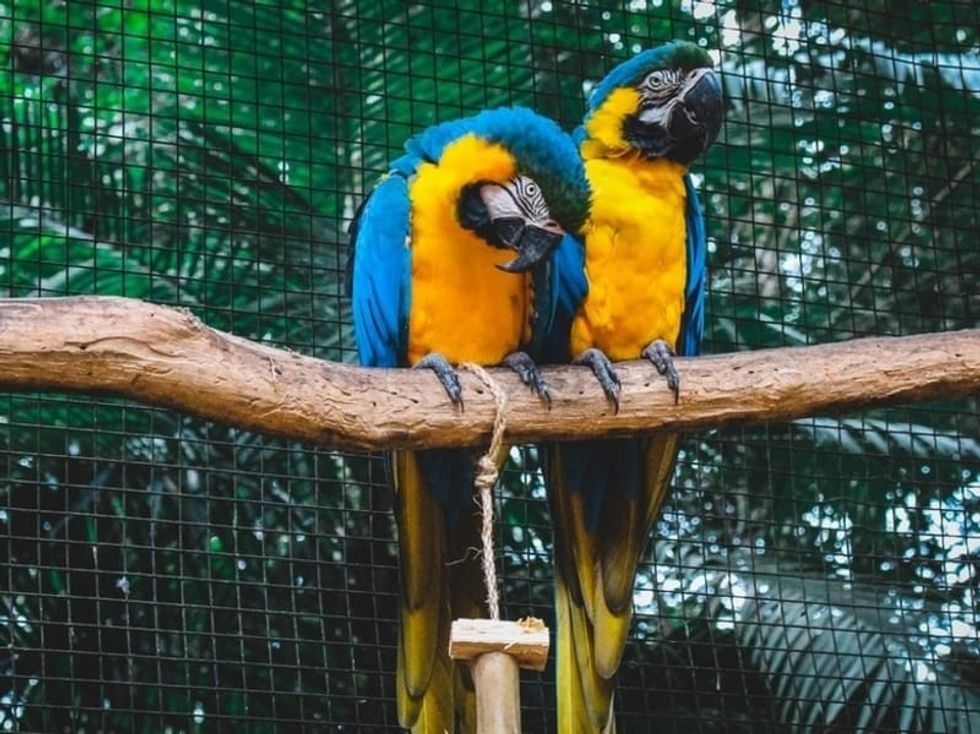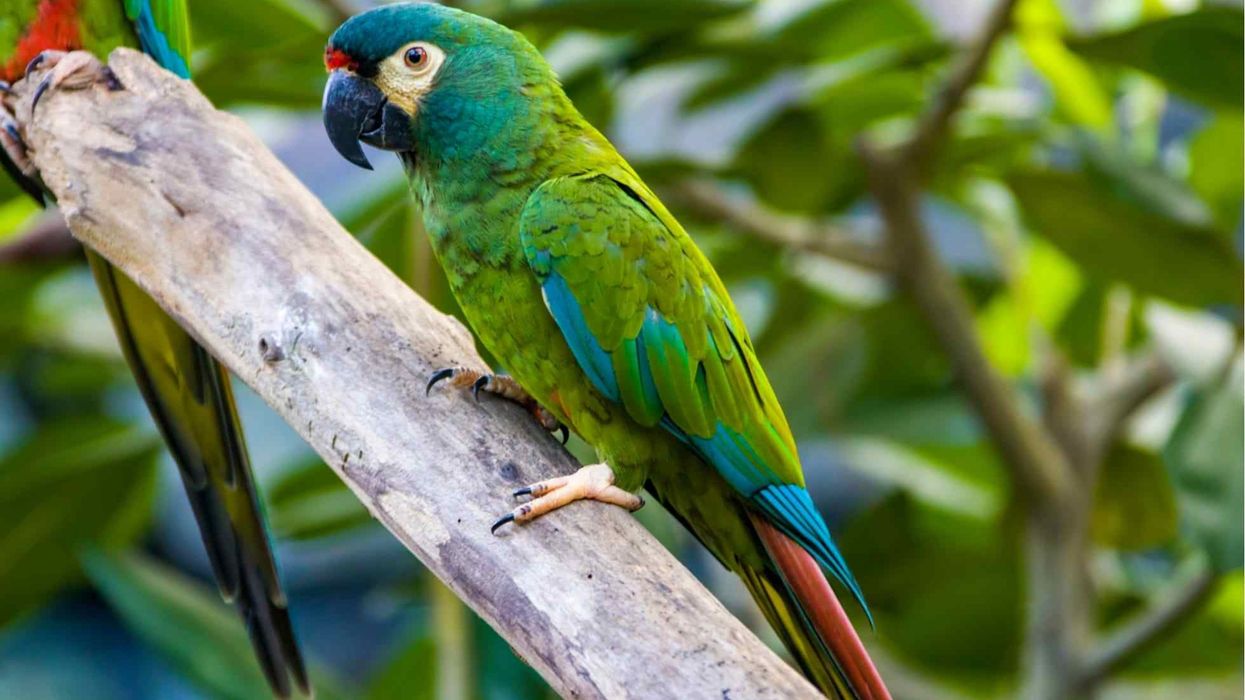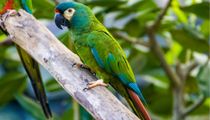Fun Blue-winged Macaw Facts For Kids

Blue-winged macaws are also known as Illiger's macaws. Illiger's macaws' species are found in central and eastern Brazil and some parts of South America and Argentina.
Blue-winged macaws belong to the Animalia kingdom from the Primolius genus. They are small-sized birds, around 14–17 in (35.5-43 cm) long, and weigh about 9.2 oz (260.8 g). Blue-winged macaws are intelligent and energetic birds, mostly spotted in deciduous and gallery forests.
Blue-winged macaws are fully covered with cozy feathers and a furry body. They are green in color with blue and yellow effects on the head.
Illiger has a small red patch near their eyes and forehead and also around their belly. In addition, they have pointed tails with yellow and reddish effects. These macaws (scientific term: Primolius maracana) have blue wings, and this is why they are called blue-winged macaws.
They are cute with chubby bodies and bold nature. The young blue-winged macaws look similar to their parents but usually have darker eyes.
Illiger's macaws' species profile confirms they are omnivores. They eat all types of seeds, fruits, and crops depending on the area they live in.
The common diet of this bird, the Illiger's macaw, includes vegetables and fruits such as carrots, peas, palm nuts, corn, tomatoes, papaya, green beans, spinach, broccoli, figs, oranges, mangos, cantaloupe, and apples. There are a few toxic feeding foods that these birds should avoid, such as chocolate, alcohol, and avocado.
The Illiger's macaw needs a diet full of proteins and nutrients to stay energetic and healthy.
This bird gets bored with the same food very quickly. Read on to learn more things about this bird.
If you like reading this, then you must also give read glaucous macaw and great green macaw facts.
Blue-Winged Macaw Interesting Facts
What type of animal is a blue-winged macaw?
Blue-winged macaws are birds that are relatives of parrots from the kingdom Animalia.
What class of animal does a blue-winged macaw belong to?
Blue-winged macaws belong to the Aves class i.e. they are birds from the Primolius genus. The scientific name of this macaw is Primolius maracana.
How many blue-winged macaws are there in the world?
No specific data is available concerning the population of Illiger's macaws. According to many reports of 2020, blue-winged birds are declining due to illegal catching, industrialization, destruction of forests, and selling of the birds as pets to be kept in a cage in captivity.
Where does a blue-winged macaw live?
Macaw (Primolius maracana) birds are one of the wild animals found all over the world in deciduous evergreen forests and tropical savanna areas. Illiger's macaws' species are also sought after in the pet trade, where most people keep them as their pets in their houses in a cage-like setup in captivity.
What is a blue-winged macaw's habitat?
The macaw (Illiger's) bird species are found in eastern Brazil and in some parts of Central, North, and South America. During the breeding season, they migrate to North Argentina in February. The average temperatures they need to survive are 107.7°F (42°C).
Illiger's macaws are generally spotted in evergreen, deciduous forests, especially rainforests. However, some of the species also live in savannahs and woodland-like habitats. Illiger's macaws are omnivores and depend on the diet, including fruits, palm nuts, berries, leaf buds, seeds, and nuts.
Who do blue-winged macaws live with?
Illiger's macaw species are friendly and love to spend time with people as their pets in a cage. These bird species live in family groups, pairs, or flocks of 10-30 to keep each other safe from predators such as birds of prey and large snakes.
Illiger's macaws don't prefer living with other species; they love to spend time with their partners, groups, or alone.
How long does a blue-winged macaw live?
The blue-winged macaw bird has a life span of 50-60 years which is high compared to other bird species.
How do they reproduce?
The blue-winged macaw (Primolius maracana) bird species breed from December to June. During the breeding season, they are generally spotted in Brazil in December and in Argentina in February.
The Primolius maracana is a monogamous bird which means that it mates with only one partner lifetime and has an amazing bonding with them. They start reproducing upon reaching sexual maturity, usually at the age of two to three years. Females prefer a large rectangular-shaped cage that is comfortable for laying eggs.
The blue-winged macaw (Primolius) bird needs a fully privatized area for breeding. They usually use shields to cover themselves while mating to focus only on breeding and avoid the looks of their neighbors.
The Illiger's macaw checks its eggs very often and avoids loud noises. To disturb these birds while mating may create a problem for the female and may cause her to take flight and crush her eggs.
The average litter size of the Illiger's macaw bird is one to four eggs, and there is a 10 day incubation period. During the incubation period, the eggs will remain with the female, and she makes sure that most of them will hatch in that period, whereas the male guards the cage and the female.
Mini macaws become fully independent after 11 weeks and usually look like relatives of parrots and take their first flight, and are ready to protect themselves from threats and defend their territories.
What is their conservation status?
According to the IUCN and other wildlife organizations, the blue-winged macaw (Primolius maracana) is listed under Near Threatened and is a pretty rare bird to find. The population of the macaw (blue-winged) is declining at an alarming rate.
Illiger's macaw (blue-winged) faces threats such as industrialization and the destruction of forests. Many scientists and researchers are working and making several legal restrictions to avoid loss.
Technology is improving and creating various difficulties for wildlife. The main threats of the Illiger's macaw are illegal catching, industrialization, destruction of forests, and selling of the birds as pets.
Blue-Winged Macaw Fun Facts
What does a blue-winged macaw look like?
The Illiger's macaw has a chubby body structure with furry wings and a pointed tail. The blue macaw is green in color with a small red patch on the forehead and near the belly.
The feet of the macaw is usually brown and have a yellowish effect on the inner body and reddish on the tail and lower back. It has blue-colored wings, crowns, and cheeks and looks like a relative of parrots.

*Please note that this is an image of a blue-and-yellow macaw, not a blue-winged macaw specifically. If you have an image of a blue-winged macaw, then please let us know at hello@kidadl.com.
How cute are they?
Macaws are colorful birds that look like parrots with a cheerful and friendly nature. They are cute, goofy, and have bold personalities, and like usual parrots, are usually kept in a cage in captivity.
How do they communicate?
The Illiger's macaw communicates using various methods, such as destructive chewing and loud vocalizations. Loud calls, screams, echoes, and squeaks help in identifying the macaw parrot. Yes - they do scream and vocalize a lot! Blue-winged macaws usually vocalize to protect their territories, communicating in flocks and recognizing one another.
How big is a blue-winged macaw?
The blue-winged macaw bird is medium-sized and is one of the small macaw species. Illiger's macaws are 14–17 in (35.5–43 cm) long and 34-36 in (86.3-91.4 cm) tall.
The macaw parrot has a pointed tail about 32 in (81 cm) long with a wingspan of 41-49 in (104-124.46 cm). Therefore, the Illiger macaw bird is five to six times bigger than Pygmy parrots (smallest parrot).
How fast can a blue-winged macaw fly?
Blue-winged macaws fly up to 35 mph (56.3 kph). They migrate from one habitat to another and cover many miles during the breeding season. The main predators of blue-winged macaws are large snakes and birds of prey.
How much does a blue-winged macaw weigh?
The weight of blue-winged macaw birds is around 9.2 oz (260.8 g).
What are the male and female names of the species?
There is no independent name for both species. The male and female of the species are known as the male blue-winged macaw and the female blue-winged macaw. They are also known as ara macaws. Adult size is between 14-17 inches (35.5-43 cm) with a life expectancy of 60 years.
What would you call a baby blue-winged macaw?
Blue-winged macaw babies are known as mini macaws or young macaws. The young ones live with their female macaws until they reach sexual maturity, usually at the age of three to four years.
The weight of the baby macaw is between 0.5-0.7 oz (14.1-19.8 g). Female macaws feed them and protect them until they are strong enough to protect themselves and their territories.
What do they eat?
The feeding pattern of the blue-winged macaw is quite simple and full of proteins and nutrition. They are known for their energetic and friendly behavior, and also it is very easy to feed them.
Female macaws or owners feed them with a diet that includes fruits, berries, leaf buds, seeds, and nuts. They are omnivores and sometimes also prefer small snails and insects, which are easy to catch and eat.
Are they dangerous?
No, Illiger's macaws are not dangerous to humans and are also not harmful to the ecosystem or the environment.
Would they make a good pet?
Yes, Illiger macaws are one of the most loyal pets with a friendly and energetic nature. They absolutely love their owners.
Macaws have certain plus points, such as their willingness to learn, intelligence, and talking ability, making them a great pet. Many articles show that it might be hard for first-time bird owners to handle the mood swings of the parrot species. Macaws are sometimes very aggressive and get bored very quickly.
Many reports and articles also consider it as a good pet. They have basic feeding habits and friendly nature, which make them good pets.
The macaw (Illiger) needs a proper pet stand or cage and plays a major role for a parrot.
The cage should be placed in a safe place where the parrot can sit while the owner is doing personal activities like cleaning, watching television, and others. It will ensure the safety of the Illiger's Macaw from engaging in dangerous activities such as flying into windows, flight, and chewing wires.
Please adhere to your local laws and regulations regarding these animals as pets, regulations may vary from State to State and Country to Country.
Did you know...
In some of the areas, it is banned and illegal to own some of the species of macaws as pets. For example, blue-headed macaws, blue-throated macaws, lear's macaws, and Spix macaws are banned, and shortly, we can expect hyacinth macaws and Buffon's macaws also to be banned.
The average cost of Illiger's macaw is $1,000-$3,000.
The ara macaw or Illiger's macaw tends to mate between December to June. During the breeding season, the female is more active than the male.
The ara macaw female needs a rectangular cage for laying eggs which is more comfortable and safe. The average litter size is between one to four eggs per season. The female sits near the eggs during the incubation period of 10-29 days.
Males protect the eggs and females. The mini macaw reaches sexual maturity at the age of three to four years and is ready to fly after 11 weeks.
What is the rarest macaw?
According to the IUCN Red List, the Spix's macaw is the rarest macaw. The common name of the Spix macaw is little blue macaw.
Can blue macaws talk?
Yes, the Illiger's macaw can talk and also mimic human speech. However, it usually uses loud tones for communication.
Here at Kidadl, we have carefully created lots of interesting family-friendly animal facts for everyone to discover! For more relatable content, check out these military macaw facts and sanderling facts for kids.
You can even occupy yourself at home by coloring in one of our free printable blue-winged macaw coloring pages.
We Want Your Photos!
More for You
See All
Bachelor of Commerce specializing in Accounting and Finance, Master of Business Administration

Divya RaghavBachelor of Commerce specializing in Accounting and Finance, Master of Business Administration
With a diverse range of experience in finance, administration, and operations, Divya is a diligent worker known for her attention to detail. Born and raised in Bangalore, she completed her Bachelor's in Commerce from Christ University and is now pursuing an MBA at Narsee Monjee Institute of Management Studies, Bangalore. Along with her professional pursuits, Divya has a passion for baking, dancing, and writing content. She is also an avid animal lover who dedicates her time to volunteering for animal welfare causes.
Postgraduate Diploma in Management

Sakshi RaturiPostgraduate Diploma in Management
Sakshi has experience in marketing strategy, social media planning, and recruiting industry experts for capstone projects, she has displayed a commitment to enhancing their skills and knowledge. She has won multiple awards, including a Certificate of Appreciation for Creative Writing and a Certificate of Merit for Immaculate Turut, and is always seeking new opportunities to grow and develop.
Disclaimer
1) Kidadl is independent and to make our service free to you the reader we are supported by advertising. We hope you love our recommendations for products and services! What we suggest is selected independently by the Kidadl team. If you purchase using the Buy Now button we may earn a small commission. This does not influence our choices. Prices are correct and items are available at the time the article was published but we cannot guarantee that on the time of reading. Please note that Kidadl is a participant in the Amazon Services LLC Associates Program, an affiliate advertising program designed to provide a means for sites to earn advertising fees by advertising and linking to Amazon. We also link to other websites, but are not responsible for their content.
2) At Kidadl, we strive to recommend the very best activities and events. We will always aim to give you accurate information at the date of publication - however, information does change, so it’s important you do your own research, double-check and make the decision that is right for your family. We recognise that not all activities and ideas are appropriate for all children and families or in all circumstances. Our recommended activities are based on age but these are a guide. We recommend that these ideas are used as inspiration, that ideas are undertaken with appropriate adult supervision, and that each adult uses their own discretion and knowledge of their children to consider the safety and suitability. Kidadl cannot accept liability for the execution of these ideas, and parental supervision is advised at all times, as safety is paramount. Anyone using the information provided by Kidadl does so at their own risk and we can not accept liability if things go wrong.
3) Because we are an educational resource, we have quotes and facts about a range of historical and modern figures. We do not endorse the actions of or rhetoric of all the people included in these collections, but we think they are important for growing minds to learn about under the guidance of parents or guardians.







